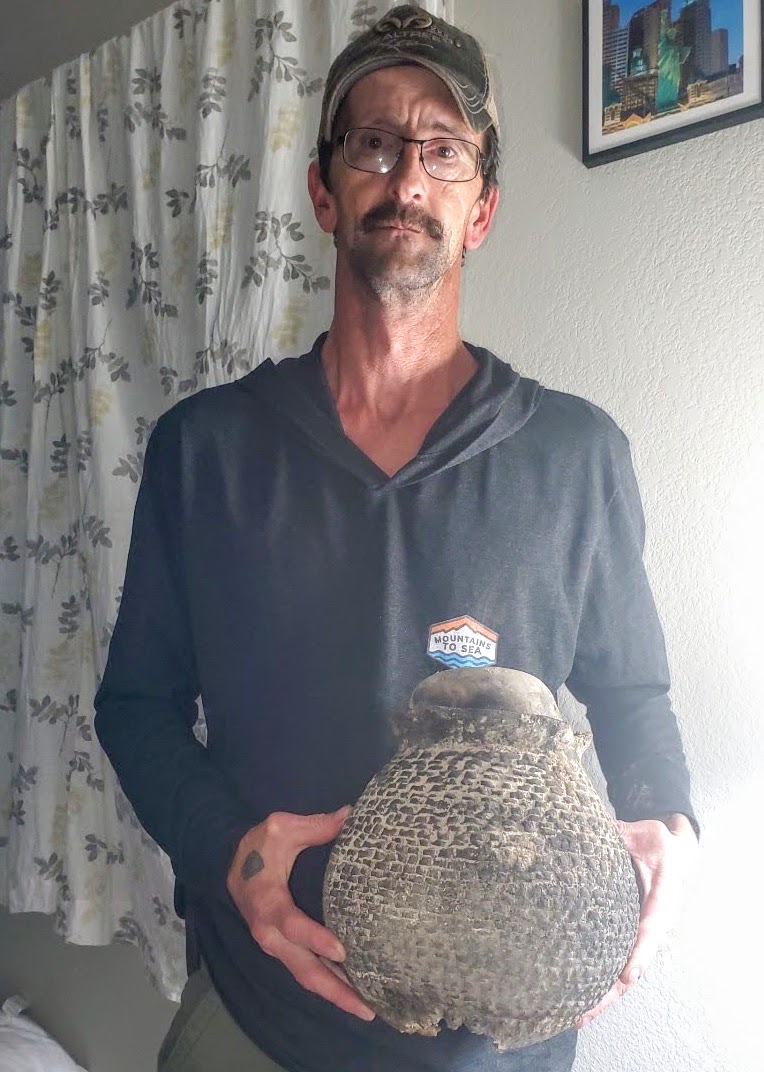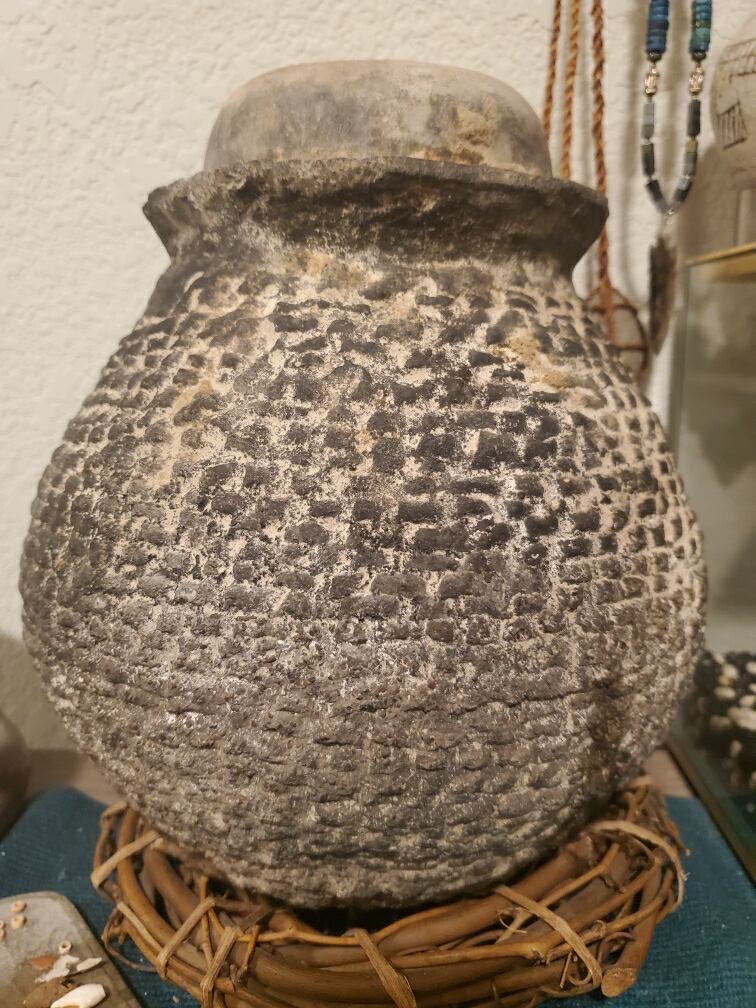Pot of Gold: Rancher’s Stunning Indian Artifact Find Brings Past Alive

When a curious rancher stumbled into a forgotten cave in search of straying cows, he discovered one of the most incredible Native American artifacts on record. Hidden beneath a rocky overhang and forgotten for a millennium, a 10”-tall clay pot was found with its sealed lid intact, protecting a golden treasure within: almost 5 lb. of phenomenally well-preserved corn harvested 1,000 years in the past.
The story of the pot’s stunning find, outrageously unlikely survival, and implications for modern agricultural research is stitched together by ranch owner Steve Campbell, an authority on Native American stone tools who has scoured fields and walked rivers since childhood, and amassed a museum-worthy collection of 10,000-plus items.
“Unbelievable and beyond rare,” he says. “Never dreamed I’d see anything like this pot. No doubt, this corn was someone’s last harvest and they never came back for it. The end.”
Once in a Lifetime
The addiction began early. At age 6, Campbell found an arrowhead—a beautiful, heavily patinated agate—and was hooked. “That was my first point ever and came from below a prehistoric campsite. It was nothing special to anyone, except it was everything to me, and the hunt went right into my blood,” he recalls. “Even to this day, it is the centerpiece of one of my displays. Always will be.”
Campbell was raised in the High Plains of northeast Colorado, and his grandmother was full-blooded Cherokee. His present pursuit of the past is related to family, history, and the outdoors. “I’ve been collecting Indian knives and points since I was a tiny kid and I had several mentors really help me. Even now as an adult, the feeling I get on finding an arrowhead is just as amazing as when I was little. Real hunters know what I’m talking about: I can go for hours in search of just one single point, and it’s purely about passion and learning.”
In spring and summer, Campbell hits shallow rivers, searching sandbars in hopes of finding a paleo smoker—a Folsom, Hell Gap, or Cody Complex specimen, or whatever ancient tool is exposed on the surface for a blink of time. In 2014, neck-deep in water, emerging onto a riverbank, he caught the gleam of a 12,000-year-old, translucent Clovis point—entirely distinct from the surrounding gravel. “That was my first Clovis, and I’ve found several more since. I’m usually ankle- or knee-deep in the river, walking against the water and using the sun to light up the bed.”
However, the source of Campbell’s true obsession rests in the arid southwest corner of the Centennial State, and he owns several small ranches in the Four Corners, specifically in Arizona and New Mexico. “Southwest archeology and artifacts are my love,” he says. “I’ve found things that are true jaw-droppers and I’ve seen other people’s finds that just blew me away. But then again, maybe nothing prepared me when I saw the pot and corn. Once in a lifetime.”
Golden Bounty
In 2015, a friend told Campbell about the availability of a rare Pueblo pot found and sold by a Montezuma County ranching family. Campbell jumped at the opportunity: “There was no way I could let it slip away and the background story was rock-solid.”
The rancher, and finder of the pot, owned land outside Mancos. His family requested anonymity, but his daughter provided provenance and a written account regarding the pot’s discovery, according to Campbell.
In a window between the late 1960s and early 1970s, during his late teens or early 20s, the Mancos rancher was moving cattle across a creek, when he entered an adjacent canyon and slowed for a break. Noting an overhang above—and a consistent sheltering spot for cows—the rancher hiked up and stepped over what he assumed was a peculiar “round rock” atop the dirt outside the overhang.
Entering the overhang, and walking through the dusty ground littered with hoofprints, he eyed a gray, coil-design pot at the rear of the cavern, almost tucked in a corner—likely only feet from where the original owner and possibly maker placed the object 1,000 years in the past. The pot had been disturbed from its millennium-long position and knocked over by the livestock, but astonishingly, it was in relatively pristine condition despite frequent proximity to the legs and hooves of 1,000-lb. cows, other than a small break at the bottom—explaining the presence outside the overhang entrance of the “round rock,” which was part of the pot, and likely kicked out by the cows.
The rancher scooped up the precious find, carried it home, and placed it high on a shelf, where it sat for decades, clinging tightly to its golden bounty.
“Dropped Yesterday”
Approximately 27.25” in circumference and 10” in height, the “pinch pot” was made between A.D. 900-1,200 by Puebloan people, and was a two-piece production—body and lid. The maker, probably a Pueblo woman, left her unintentional signature—fingerprints in the clay. “This is a dual-use, corrugated cooking and storage pot, and the lid was supposed to be used for a bowl. Basically, they had two containers in one,” Campbell explains. “I’ve seen this design many times and I’ve got a couple other objects with identical designs from around Mancos.”
“It’s a coiled construction. They rolled out a piece of clay and then coiled it and pinched as they went up, kind of like connecting a bunch of snakes and pinching until they reached the lip. You can see clear thumbprints in the clay on several places. It was originally light gray, and used for cooking, and the heating marks are still easy to make out.”
Although beautifully crafted, the vessel is utilitarian, Campbell insists. “We see this incredibly pretty pottery and we think it was about something to look at. No. I’d estimate 90% of artifacts found today were utilitarian and related to survival.”
Fastened with pine pitch, sand, and dirt, the top lid remains tightly sealed—indicative of attention placed on preservation. “They were probably living under that overhang area,” Campbell says. “If an archeologist excavates that overhang, they’ll find remains of habitation. That pot was placed in there and packed with 5 pounds of corn for a food source, maybe if something went wrong with the next year’s harvest. It was surplus and they were depending on it. Something happened to those Indians and they weren’t able to return.”
Despite the lid’s seal, the off-yellow corn was accessible to Campbell through the small, damaged hole at the vessel’s bottom. “The corn kernels are in about perfect condition. No moisture, no sun, and sealed in that pot for 1,000 years, the corn looks like you can’t believe.”
Campbell has provided corn samples to several universities. The decades-long search for indigenous varieties of corn is vital for research on nitrogen-fixing grain—corn that sources nitrogen from the atmosphere and doesn’t require synthetic fertilizer. Find a lost trait; introduce it into current varieties; and thereby reduce the fertilizer needs of a modern crop. “The scientists want to know how this particular corn grew so well and if it’s now extinct,” Campbell says.
Agricultural remains are a consistent feature of Campbell’s discoveries on his property and on ground belonging to his ranching friends. Below a particular habitation site located on Campbell’s land, spread over several acres, the traces of cultivated corn rows are visible, he details: “It’s in a small valley below another overhang. You get down low to the ground and look up the valley, and you can actually see the remains of the rows. How much corn were the Indians able to work? How much did it yield? I don’t know, but this spot is about 3 to 4 acres.”
Beyond corn, Campbell has found other crop specimens, including beans and gourds. “I’ve found lots of beans. I once found a corn cob with some of the kernels still attached in a cave. I also found human feces at that site and archeologists came and took several specimens to measure diet. My buddy found a gourd-shaped watermelon at a site, and it was unbelievable because the black seeds inside grew when we planted them. Best watermelon I’ve ever tasted. The climate out here keeps things intact and I’ve come across things that you’d swear were dropped yesterday.”
Life and Death
The pinch-pot vessel is a time machine, Campbell explains. “I want future generations to always know about this pot. The people who made it were just like us, trying to grow and keep food to survive.”
“It’s humbling to hold something in your hands that people saved for survival,” he concludes. “In a lot of ways, this pot of corn may have been the divider between life and death for someone long ago. Nobody goes to all that effort and walks away from that much corn.”
For questions or to read more stories from Chris Bennett (cbennett@farmjournal.com), see:
Skeleton In the Walls: Mysterious Arkansas Farmhouse Hides Civil War History
While America Slept, China Stole the Farm
Bizarre Mystery of Mummified Coon Dog Solved After 40 Years
Where's the Beef: Con Artist Turns Texas Cattle Industry Into $100M Playground
The Arrowhead whisperer: Stunning Indian Artifact Collection Found on Farmland
Fleecing the Farm: How a Fake Crop Fueled a Bizarre $25 Million Ag Scam
Truth, Lies, and Wild Pigs: Missouri Hunter Prosecuted on Presumption of Guilt?
US Farming Loses the King of Combines
Ghost in the House: A Forgotten American Farming Tragedy
Rat Hunting with the Dogs of War, Farming's Greatest Show on Legs
Misfit Tractors a Money Saver for Arkansas Farmer
Predator Tractor Unleashed on Farmland by Ag's True Maverick
Government Cameras Hidden on Private Property? Welcome to Open Fields
Farmland Detective Finds Youngest Civil War Soldier’s Grave?
Descent Into Hell: Farmer Escapes Corn Tomb Death
Evil Grain: The Wild Tale of History’s Biggest Crop Insurance Scam
Grizzly Hell: USDA Worker Survives Epic Bear Attack
A Skeptical Farmer's Monster Message on Profitability
Farmer Refuses to Roll, Rips Lid Off IRS Behavior
Killing Hogzilla: Hunting a Monster Wild Pig
Shattered Taboo: Death of a Farm and Resurrection of a Farmer
Frozen Dinosaur: Farmer Finds Huge Alligator Snapping Turtle Under Ice
Breaking Bad: Chasing the Wildest Con Artist in Farming History
In the Blood: Hunting Deer Antlers with a Legendary Shed Whisperer
Corn Maverick: Cracking the Mystery of 60-Inch Rows










